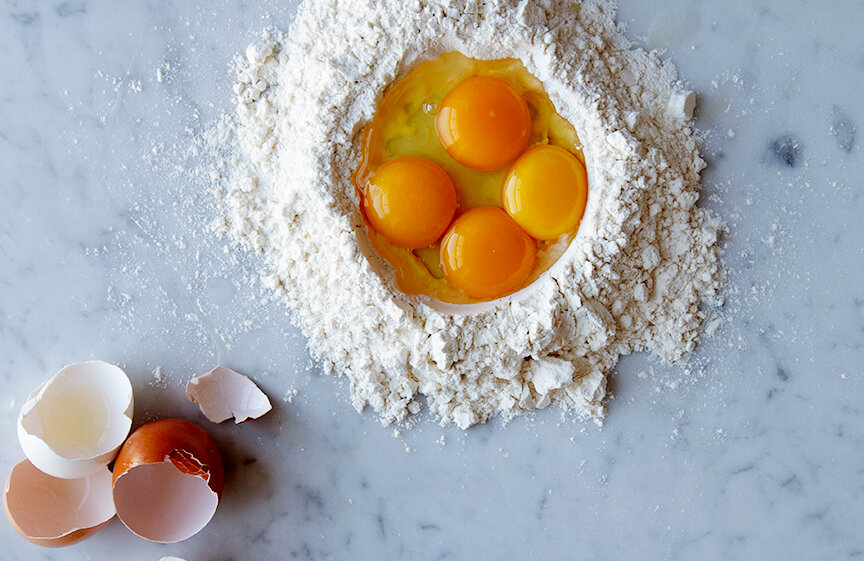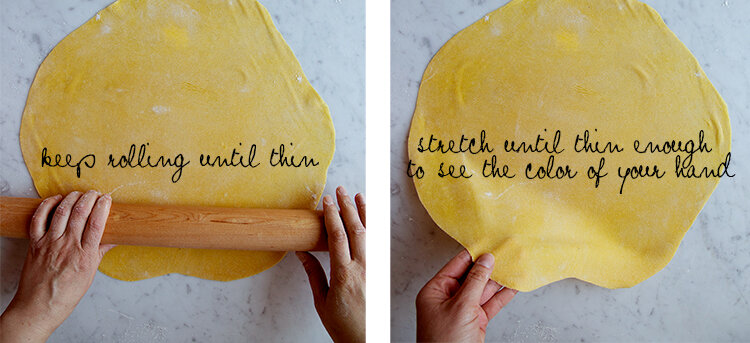This pasta recipe is my all-time favorite. I have made it so many times over the years and its my go-to every time. Occasionally, I’ll try a new pasta recipe version – with less eggs, with only whole eggs, adding olive oil, adding lots of water – you name it, and I keep coming time after time to this one. It is a simple recipe containing only eggs and flour. I discovered its original version watching a Julia’s Child episode of ‘In Julia’s Kitchen with Master Chefs’ with Jimmy Sneed where he was so charming, showing Julia how to make pasta telling her that everyone can make a pasta, even a child can do it! At the time I watched the episode for a first time, I had never made pasta before in my life. I was super intimidated by pasta making, thinking of it as this big, scary, fancy thing requiring years of special chef training, also that I must an Italian grandma, or at the very least must be living in Italy, breathing Italian air, and eating only double 00 flour in order to be able to make a good pasta. I don’t know about you, but growing up my mom only bought packaged dry pasta and the woman was a fabulous home-chef, baking bread and cooking cow’s tongue, but she never made pasta, so I never thought that could I possibly do it myself. My other mental obstacle (yes, it’s always the head, isn’t it?) was that for years I believed that pasta can’t be made without a pasta roller/machine. And I thought to myself “I can buy one, but what if I suck at pasta making and then I just blew $80 bucks and have a gadget that I can’t use for anything else! ” That is why that episode of Julia Child and Jimmy Sneed was so revolutionary for me – a turning point in my beliefs about pasta, challenging all of them. And the whole owning a pasta rolling machine, I got over that thought after having the realization that Italian grandmas have made pasta for years and years, far before the pasta machine became available, so if they can do it I can do it too. As a famous slogan goes: Just do it :) so, I put my apron on and I did it, and fresh pasta has become one of my favorite things to cook.
About the pasta dough: the original recipe called for half all-purpose flour and half semolina flour. The large quantity of semolina makes for a denser pasta and I personally prefer a soft pasta that is strong enough to hold ravioli filling, or thin noodles without falling apart. I also found that adding more semolina makes for a very hard dough to roll, mainly due to the high yolk content. So over the years I perfected the pasta consistency to what I like – a firm textured pasta, yet silky and very flavorful. In the recipe I call for mostly all-purpose flour and only a tablespoon of semolina in the dough. Additional semolina is used for the already made noodles as they are being tossed in the semolina, preventing them from sticking together. If you are a beginner at pasta making don’t despair if it doesn’t turn right the very first time, and don’t be an overachiever starting with ravioli, try an easy to cut pappardelle. And if you have a hard time rolling this eggy dough. Start over, or try a different recipe like this one.
How to make homemade pasta without pasta maker
Serves 4
Ingredients:
• 1 cup of all-purpose flour (plus more for dusting)
• 1 tbsp semolina flour (plus more for preventing pasta form sticking together)
• 1/2 tsp salt
• 3 egg yolks*
• 1 whole egg
*Wondering what to do with those 3 leftover egg whites? Make some meringues. They are so silky and wonderful to snack on, or crumble them over your favorite ice cream
Directions:
Start with 3/4 cup all-purpose flour as the size of egg yolks vary. On a clean work surface or a mixing bowl place flour, semolina and salt. Make a well in the center and add egg yolks and the egg. Starting from the center using a fork (easier to clean up and work with) or your fingers start by mixing the eggs together, working outward from the center of well, gradually incorporate flour mixture into egg mixture until a irregular dough forms. If using your hands and they are sticky, remove as much dough from them and wash hands before kneading the dough otherwise you will find it difficult to work. If the dough seems sticky add the remaining flour 1 tablespoon at a time. If the dough becomes stiff add 1 tablespoon of water, but only enough to keep the dough together.
Transfer to a lightly floured work surface and knead until dough is smooth and springs back when pressed with a finger, 8 to 10 minutes. While kneading, add more water, 1 tablespoon at a time, if dough feels too dry; or add more flour, 1 tablespoon at a time, if dough feels too sticky.
Shape dough in a ball, wrap it in a plastic wrap. Let it rest on the counter for 30 minutes.
Roll out the pasta: cut the dough in half. Roll out one half at a time, keeping the rest of the dough wrapped. Very lightly flour the work surface. Shape the dough into a ball. Press dough down so it flattens like a disk. Start rolling by placing your rolling pin in the center of the disk and roll away from you and then back towards you to even out the dough thickness. Lift up the dough and turn it 90 degrees, roll in the same manner described. With each pass as you roll, lift the dough up, re-dust the counter beneath if needed, and turn it over. Keep rolling and stretching until the pasta is thin enough to see the color of your hand or its print through it.
For pappardelle: flour the dough really well, roll it and cut strips as wide as you prefer. When done cutting, loosen up the ribbon-like strips and toss them generously with semolina. Place in an airtight container until ready to boil.
For ravioli: see my next post.
Repeat with the remaining dough.
To cook the pasta: Bring a pot of salted water to a boil. Shake off the extra semolina and add the pasta handful by handful to the water, gently stir, lower the heat to a medium-high and cook for 5 minutes. Taste a noodle to check if it is done to your desired firmness.



















